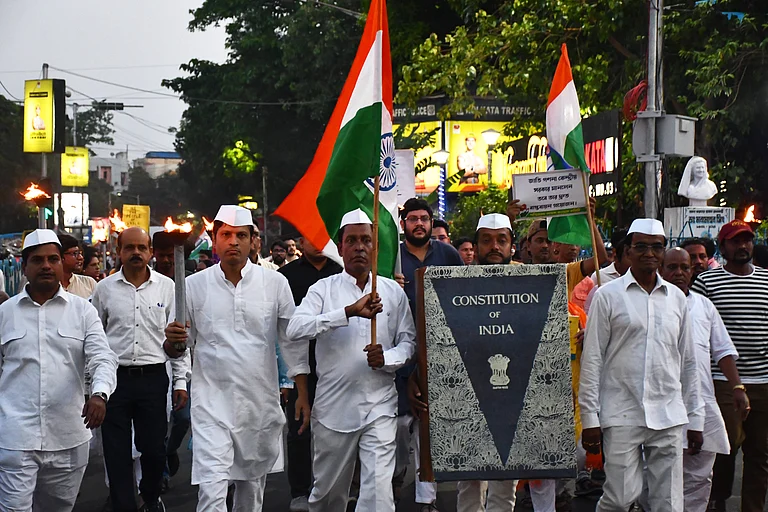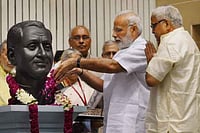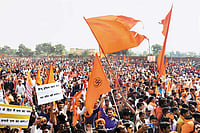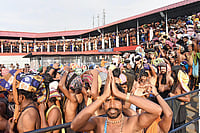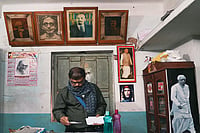
The RSS never sought publicity and most of its pracharaks even today lead a low-profile.
The expansion of the shakha network commensurated with its nationwide influence and the need to interpret its approach to national issues.
Today, the RSS has publications in every language and it is said that the combined circulation of Sangh publications is almost two million.
It is quite a marvel that an organisation that has eschewed publicity for almost a quarter of a century of its existence has today come to occupy the centre stage of the Indian national narrative.
The Rashtriya Swayamsevak Sangh (RSS) founder Keshav Baliram Hedgewar used to say that the RSS’ work will speak for itself and it will not go after publicity. For almost 25 years—since its inception in 1925 on Vijayadashami Day—the RSS had no publication of its own. It never sought publicity and most of its pracharaks even today lead a low-profile, reticent lifestyle.
To begin with, the Sangh depended on word-of-mouth publicity. It was basically the organisation and network that was fulfilling the transmission of ideology and the spread of organisational methodology. As it got into the national arena as a rejuvenating, reinventing, and reimagining ideological force, the need for explicit exposition of its programmes, policies and approach came into the limelight. In the post-Partition era, the falsehoods spread around the Sangh after Mahatma Gandhi’s assassination forced the RSS to define its existential values.
The expansion of the shakha network commensurated with its nationwide influence and the need to interpret its approach to national issues. This created a need for having its own publications, particularly at a time when the mainstream media shunned any kind of sympathy towards the work of the RSS. The RSS entered many new areas, including politics, labour and student activities. Its shakhas even reached global dimensions, with the Indian diaspora increasingly attracted towards the Hindutva philosophy. Great leaders like Deendayal Upadhyay, A. B. Vajpayee and L. K. Advani started their public careers as editors of Sangh publications. Shri Guruji Golwalkar was a prolific writer and orator. The Sangh produced a large number of eminent journalists and writers like P. Parameshwaran, K. R. Malkani, V. P. Bhatia, R. Hari, H. V. Sheshadri, Jay Dubashi, S. Gurumurthy, Ram Madhav, Bhanupratap Shukla, Dinanath Mishra, Sunil Ambekar, and J. Nanda Kumar. Initially, the Sangh publications became the launching pad for swayamsevaks.
The RSS former Saha Prachar Pramukh Shri J. Nandakumar, who is now looking after Prajna Pravah, which is a Sangh think tank, said: “The RSS has 15 monthlies and weeklies, 39 Jagaran Patrikas, four dailies and 18 publications. It also runs a TV news channel Janam.” Nandakumar says, “The Sangh, which places emphasis on selfless service for societal transformation, has traditionally remained averse to publicity. However, it initiated Prachar Vibhag to counter the high-decibel tirade unleashed by vested interests seeking to propagate a negative and distorted narrative against the Sangh and its ideals. So, it became imperative for the Sangh to uphold and project a positive, nationalistic vision in the supreme interest of the nation. This does not signify a departure from its core approach to publicity.”
The RSS has dominated the Indian public discourse in the last few decades and it has almost changed the way India thinks. It today has one of the largest networks of publications, having dailies, TV channels, weeklies, fortnightlies and monthlies. Its outfits are active in the social media segments as never before. There is no area of activity that the RSS publicity wing has not entered. Today, the organisation has a full-time senior pracharak looking after its outreach at the level of Sah-Sarkaryavah in charge of prachar (social outreach). The Sangh directly does not own any publication. As sarsanghchalak Mohan Bhagwat is fond of often saying, “The Sangh will not do anything, but swayamsevaks will enter every field.”
Today, the RSS has publications in every language and it is said that the combined circulation of Sangh publications is almost two million. Most of these publications are self-sufficient.
The Sangh publications have often initiated meaningful national debates, be it on cow slaughter, purification of the Ganga, Swadeshi Abhiyan, the Ram Janmabhoomi movement, the scrapping of Article 370, uniform civil code, or even electoral reforms and atrocities in the name of Waqf Boards. The Sangh started its publications in the late 1940s, after Independence, first in the form of Panchajanya in Hindi from Lucknow and Organiser in English from Delhi. Afterwards, in the early 1950s, many regional publications came under the Sangh banner. Today, it has publications in every language and it is said that the combined circulation of Sangh publications is almost two million.
At a time when printed publications are losing their readership, the Sangh publications have been able to maintain their circulation and reach. Many publications like Kesari Weekly in Malayalam run on subscription revenue more than depending on advertisements. Its circulation is over a lakh now. With time, these publications have changed their style, get-up and production quality. Almost all publications have their online versions and they reach millions of swayamsevaks across the globe.
The Sangh publications faced bans on three occasions when the RSS was banned. Yet, these publications did not find it difficult to regain its readership whenever the ban was lifted. Most of the RSS publications are in the name of private or public limited companies and they are all self-sufficient, but not making profit. They, of course, get advertisement support from the Bharatiya Janata Party (BJP)-ruled states. But they seldom get such support whenever the Congress or other non-BJP parties are in power. For long, RSS publications and even pro-RSS journalists suffered ostracisation and it was very difficult for a known RSS person to get a decent job in the field of journalism. Such discrimination still exists though the BJP is in power at the Centre and most of the Indian states.
It is interesting to compare the predominance of the Left, pro-Congress journals in the national arena. For many decades after Independence, it was the Left and the Congress publications which had sway over the media. The Communists had many publications like the Patriot, Link, Ganashakti Patrika, Deshabhimani, Janayugom, New Age and People’s Democracy. These publications used to get lavish funds from the Soviet Union and the Government of India. The Congress governments patronised both its own and the Left publications in a big way. The Congress too had publications like National Herald, Veekshanam, Jai Hind TV, Navjivan and Qaumi Awaz. Despite crores of rupees sinking into these publications, today most of them are either on the verge of closure or have disappeared from the scene.
Conversely, the RSS publications are still thriving, mainly because they are not dependent on any government support or political patronage. The funds for running the RSS publications come mainly from contributions by its cadres. Before Emergency (1975), the Bharat Prakashan, which is now running the Organiser and Panchajanya, had started a successful English daily from the national capital called The Motherland. The writings in The Motherland and the Organiser during those days were then accused as one of the provocations for Indira Gandhi to impose Emergency and press censorship. During Emergency, The Motherland office was raided and its press and machinery were confiscated and its editor K. R. Malkani was arrested under the Maintenance of Internal Security Act (MISA) along with his editorial team. Yet, during the resistance movement (Emergency), it was the RSS that played a pioneering role in the production and distribution of underground literature. After the Emergency was lifted, because of financial constraints, The Motherland could not be revived. Though the Organiser and Panchajanya reappeared on the scene, the influence of these publications was such that the Jayaprakash Narayan movement of the 1970s was essentially a product of their propaganda. In some quarters, even the split in the Janata Party in the late 1970s was also attributed to the writings in Organiser.
As far as ownership is concerned, the RSS does not interfere directly with the editorial policy of its publications. The editors are given a free hand and as the editor of Organiser for 13 years, I can vouch that at no stage did I feel any kind of pressure on issues concerning the editorial line. The Sangh generally leaves it to its trained swayamsevaks, who are appointed as editors, to respond and interpret national issues.
The Ayodhya movement was a turning point in the ideological progression of the RSS. It created a large number of news writers, artists, social media influencers and journalists. It was a defining movement in RSS history. Because of its dedication, novelty of approach and ever-growing network, the RSS publications are thriving at a time when the print media is facing a big circulation challenge.
(Views expressed are personal)
R. Balashankar is the former national convener of BJP’s intellectual cell, former editor of Organiser, and current member of the BJP’s all-India training and publication department
MORE FROM THIS ISSUE
This story appeared as '100 Years of...Influencing' in the print edition of Outlook magazine’s October 21 issue titled Who is an Indian?, which offers a bird's-eye view of the Rashtriya Swayamsevak Sangh (RSS), testimonies of exclusion and inclusion, organisational complexities, and regional challenges faced by the organisation








